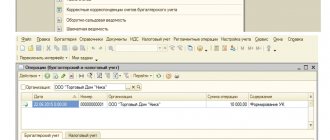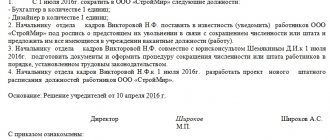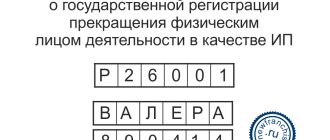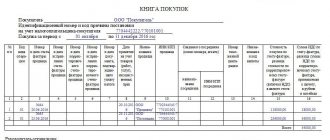Design and maintenance of the journal
Journals can be kept in paper or electronic form. In this case, registration will be carried out by a special program, which will enter the index. Some programs allow you to attach a scanned version of the order to the card.
If the magazine is paper, it must be laced. The sheets of the journal are numbered in order, and a sheet with a certification inscription with the following content is attached to the last sheet of the journal: “In total, ___ sheets are laced and numbered.”
The person responsible for maintaining the journal is the head of the management documentation department (orders for core activities), the head of the personnel department (orders for personnel) or other persons at the discretion of the organization’s management. Purpose
The title page of the journal indicates:
- his name;
- Name of the organization;
- deadlines, usually in the form of the inscriptions “Started” and “Ended”;
- Full name and position of the person responsible for maintaining the journal.
Model rules and requirements for registration of accounting books
Before you start making entries:
- all pages are numbered;
- the accounting book is stitched, the ends of the threads are sealed with white paper (or sealed with a special seal);
- indicate the number of sheets stitched, certified by the signature of the responsible person (secretary or personnel inspector), the head of the organization;
- the signature of the first manager is sealed with the seal of the organization (if any);
- The start and end dates of maintenance are specified on the title page.
Entries can be made in blue or black ink.
Not allowed:
- wiping with an eraser;
- use of various office tools for text correction;
- tearing out pages.
In situations where an error is made, the incorrect entry is carefully crossed out. After a new entry has been made, the person responsible for maintaining the registration, after clarifying that “what has been corrected is correct,” puts his signature.
If records are kept electronically, the information is periodically printed out, since changes can be made to any computer program and it will not be difficult to change the information entered earlier.
The printed sheets are also numbered, stitched, the quantity specified, signed by the person in charge and the manager, and sealed.
Title page of the journal for registering orders, sample:
Sample last page:
Magazine form
There is no legally approved form for the order register. The organization itself develops this form. You can use the sample order log below.
The journal for recording orders must contain the following required columns:
- serial number;
- section "Year";
- date and order number;
- order title;
- summary of the order “On the admission of welder I.I. Ivanov” to independent work";
- notes (for example, the deadline for executing an order).
Optionally, other columns can be added to the journal, for example, “Executor”, “Distribution” (that is, a list of persons who are affected by this order and to whom it was communicated), etc.
Structure and content of the employer's order journal
There are no unified forms for registering orders for internal use. There are standard accounting books on sale that you can use, or develop your own form and order in printed publications.
The procedure for registering documentation is standard, in the form of a table.
The pages have several fields to fill out:
- number in order of the next entry;
- date of registration of the order (which is considered the date of its issue);
- the number assigned to the order (it may not coincide with the serial number, for example, it may have additional letter designations);
- summary of the administrative document;
- who is the person responsible for the execution of the order;
- note;
- the signature of the official responsible for monitoring the execution of review or receipt of a copy of the order;
- There may be other graphs.
Storage
The storage period for the log of orders for the main activity must be no less than the storage period for the orders themselves.
When compiling an internal inventory in the process of filing a case with orders in the archive (you can read more about this in a separate article on our website), you should keep in mind that entries in the journal must be confirmed by the actual presence of the order in its physical, paper form.
If there is a record, but the document itself is missing, this is also noted.
- Certificate of no criminal record
- Reporting the consequences of an accident
- List of cases by personnel
- Route sheet
- Register of postal items
Zen! Zen! Zen! Our Yandex Zen channel has even more special legal materials in a convenient and beautiful format. Subscribe now →
The order register contains a register (list) of orders and instructions from the enterprise management. The order journal form is not unified; an entrepreneur has every right to buy a ready-made journal and fill it out according to existing requirements or develop his own form.
What is it needed for?
In order to keep the entire document flow of an enterprise under control in its daily business and economic activities, registration books are used. Of these, the main ones for any organization are logs of registration of orders and instructions of the administration:
- by personnel;
- on administrative and economic issues;
- by main activity.
Managers of small businesses often believe that it is not necessary for them to prepare a bunch of documents that, in their opinion, are unnecessary. This may be true for enterprises with fewer than three employees. But in any other cases, during the first inspection by the tax inspectorate, the bodies of the Ministry of Social Labor, the Ministry of Internal Affairs, and the Pension Fund, inspectors may request documents justifying and confirming the implementation of business transactions and expenses for them.
How to withdraw money from an LLC's current account? All legal options and detailed instructions are presented in the article.
How to draw up a probationary agreement? You will find all the necessary information here.
Looking for a payroll example? He is here.
And often the results of inspections directly depend on the accuracy and thoroughness of maintaining internal documentation of the enterprise. When inspection bodies see the legal and economic culture of the enterprise administration, high-quality and timely documentation, they usually take a more lenient approach to other issues of activity that are being inspected.
Moreover, the basic rules for maintaining documentation are enshrined in laws and regulations and are mandatory regardless of the form of ownership of the enterprise.
Types of magazines
Expert opinion
Volkov Georgy Tarasovich
Legal consultant with 10 years of experience. Specializes in the field of civil law. Member of the Bar Association.
If a journal for registering orders is prepared in free form, then it is stored for a strictly defined period of time (5 or 75 years). The storage period for a document depends on its type.
Main types of order logs:
Logbook for registering orders for personnel (type I)
Logbook for registering orders for personnel (type II)
Journal of registration of orders for main activities
Journal of registration of orders for administrative and economic activities
The order log can be kept in paper form or electronically.
Why do you need a magazine?
The legislation does not provide for punishment for the absence of a journal on the main activities of the company, and the main instructions for its preparation are not established. Companies are developing their own magazine format, guided by the Law “On Accounting” dated December 6, 2011. No. 402-FZ.
The journal reflects all orders issued by management regarding personnel . Maintaining such a document makes it possible to track the current order, the chronology of the publication, orientate yourself and quickly find the necessary order. The log records all work activities of employees at the enterprise.
In the event of litigation between the company's management and personnel, the journal will be essential evidence .
Is it necessary to keep such a journal? No, but it is very convenient. However, if you refuse such a document, no one will fine you.
Personnel – all company personnel (permanent and temporary) employed in the company’s labor sphere.
Official labor relations between the organization and the employee arise after the signing of the contractual relationship. After signing the contract on both sides, the employee is automatically enrolled in the staff .
Here you can read in detail about what “staff” and “staffing” are.
Appearance of the document, description of its fields, content
There are no strict requirements for the form of the order journal. Usually this is a barn notebook with A4 sheets, lined up in accordance with standard rules.
Before use, the pages of the magazine are numbered and the magazine is stitched. On the last page, the magazine's firmware threads are sealed with the company's seal.
Under the seal, make a note about how many pages are numbered and stitched.
Traditionally, the form of the order journal involves the presence of several sections:
- Title page.
- The initial section, including the names of the employees responsible for maintaining the journal.
- The main section (“body” of the journal), including registration data about orders.
When preparing the title page, indicate:
- the name of the company in which this document is maintained;
- place of jurisdiction (city, town, urban settlement, etc.);
- name of the structural unit (for example, “administrative department”);
- title of the magazine;
- filling start date;
- closing date (set after completion of filling out the document);
- period of storage of the log after completion of filling;
- volume number (if the journal ends before the end of the working year).
The log of orders for personnel is lined into 8 columns:
- Number in order. This column is needed to avoid issuing orders retroactively.
- Registered order number.
- Date of registration of the order (order).
- Brief content of the document.
- Last name, first name, patronymic and position of the person in respect of whom the order was issued.
- The position of the person in respect of whom the order was issued.
- Grounds for creating an order or instruction.
- Note (additional information on the document).
The journal of orders for main activities is divided into 4 columns:
- Date of issue of the order and document index.
- Full name of the person who signed the order.
- Title (title) ordered (orders).
- Note on the execution of the decision.
Orders are issued in chronological order and are also entered into the journal. When entering, the clerk takes into account the date of the document and its number, as well as the available digital and alphabetic designations accepted at the enterprise.
For convenience, orders can be assigned an individual alphanumeric code, by which it will be easy to find.
Documents relating to penalties or incentives for company personnel.
Proper organization of work is impossible without maintaining a register such as a journal for registering orders of the employer. After all, a quick search for the necessary documents, including during inspections based on complaints to the labor inspectorate, Rospotrebnadzor, etc., will protect the interests of the organization.
There are many business inspectors in our country. Therefore, the registration journal will become a way to effectively access documents in the world of work.
In addition to the register of orders for personnel (about employees), an organization can develop a register of orders for the main activities of the organization. Therefore, for convenience, we will post examples of these magazines.
Order log - title page
Order registration journal - sheet with those responsible for maintaining
Logbook for registering orders for personnel
Journal of registration of orders for main activities
What is this magazine for?
If a document is registered in an organization, then its legality and its productive power are recognized. Registration is carried out by assigning a unique number to the document. A journal for registering orders for personnel allows you to organize this type of documentation in an organization, protect the company’s activities from forgery of orders or the approval of untimely orders, or the issuance of orders retroactively .
In order for the magazine to fulfill its function, it must be numbered and laced. The documents approved by the head of the organization must be recorded in order in the journal.
Its pages may not be removed or added to, or replaced, or destroyed in any way. For this purpose, the magazine must be laced before filling it, having numbered each page first.
The lacing is secured with a special form, which indicates the number of pages in numerical and alphabetic designations, the signature of the responsible person is affixed - most often, the head of the company and a seal of the appropriate level. That is, the signature of the responsible person is secured with a seal for documents, the signature of the general director or head of the organization - with an official seal.
Do you need a journal of employer orders?
Registration of an order presupposes the existence of a certain register, the assignment of a registration number and the entry of this number into a certain form. The actual form, which contains the number and date of the order, is the journal.
The law does not establish a strict form of the journal, both for personnel and for main activities. Each employer has the right to develop and approve its own form.
In this case, the journal can be kept in paper form, or electronically. If the employer stipulates in local regulations, for example, an order, the need to print the magazine, then it will have to be made in paper form, numbered and sewn.
Typically, such responsibilities are assigned to the HR department.
Thus, the correct organization of management in an organization, in our opinion, presupposes the presence of a journal of the employer’s orders.
What orders are recorded?
If what kind of orders should be registered in the first two books of the above is more or less clear, then the third - “Logbook of registration of orders for core activities” raises the most questions and misunderstandings among the managers of small enterprises: what kind of orders should be recorded? should she get carried away? But the orders that are recorded in it are fundamental for all orders placed in the other two books.
Of course, the main subject of these orders is determined by the organizational and legal form of the enterprise and the nature of its economic activities, so it is impossible to give specific answers and recommendations for each particular case. But according to the prevailing types of orders characteristic of any organization, all their types according to the main activity can be defined as:
- Appointment of the General Director, Chief Accountant.
- Approval of a logo, brand book, advertising slogan, etc.
- Ensuring the protection of trade secrets.
- Approval or change of the organization's structure, creation and liquidation of divisions.
- Approval of regulations, instructions, rules and other internal regulatory documents.
- Approval of staffing.
- Establishing the operating mode and internal regulations of the organization.
- Conducting internal audits and certifications.
- Planning and monitoring of core activities.
- Financing issues.
- Material and technical base.
- Information and documentary support.
But what about the appointment of the director and chief accountant - these are personnel issues? However, the appointments of the enterprise's key management persons are also subjects of the main activity and must be recorded in this journal.
Contents of the employer's order log
The standard journal form includes the following columns:
- serial number of the record
- date of issue of the order
- number
- title name (summary)
- FULL NAME. (position) of the signatory
- responsible for execution
- period of execution
- information about familiarization
- performance information
Expert opinion
Volkov Georgy Tarasovich
Legal consultant with 10 years of experience. Specializes in the field of civil law. Member of the Bar Association.
The log of orders for personnel can be produced in a truncated format. In it, the responsible employee reflects information about hiring, dismissal, sending on a business trip, for training, etc.
As stated above, this is an approximate form. The employer has the right to develop a register that is convenient for him.
How long should an employer's order log be kept? State bodies have established a deadline - permanent. And we recommend that many employers do the same. Then, if employees go to court or receive requests, the employer’s order log can become evidence of compliance with labor and other rights.
To control the orders issued in the organization in the office management system, a log of orders is used. This document allows you to organize a control system for published documents, as well as track currently valid orders and their purpose using a brief description.
Registration of documents allows you to facilitate and streamline the work of the HR department. In addition, the chronological registration of issued orders allows you to protect the organization from the publication of documents “retrospectively”.
Why do you need an order log?
From a legal point of view, there are no mandatory requirements for the presence of this kind of document. But, when carrying out supervisory activities by government agencies in the field of labor relations, the inspector has the right to request a journal for registering orders of the organization.
First of all, thanks to the recorded data, you can easily trace the chronology of the sequence of events, for example:
- when the person was hired;
- whether during his working career he was transferred to other areas of work;
- whether he was subject to disciplinary and other types of liability provided for by law;
- date and reason for termination of the employment relationship.
As a rule, registration of orders in an organization is the professional responsibility of the secretary, who submits documents for signature to the manager, who receives incoming information, and who sends outgoing correspondence.
Registration of production orders allows you to save time if you need to find this or that order, including for past years of activity. Without taking into account, imagine how many hours or even days it will be necessary to leaf through all the orders collected over many years, which must be kept by the employer for up to 75 years.
We can conclude: even when transferring documents for storage to the archive, filing them in chronological order, the attached journal for recording production orders will help prevent confusion.
Maintaining a log book
The procedure for registration, execution and preparation of administrative documents issued by the organization are regulated on the basis of the developed procedure for maintaining document flow for internal use. Orders must be issued in chronological order, taking into account the date of preparation and the next serial number of the document using digital and letter designations.
Using the individual code will make it much easier to find the required document in the future. In this case, you can use certain codes to determine whether documents belong to specific departments of the organization. Grouping of orders can also be carried out according to their semantic purpose.
For example:
- “B” – status is used for documents issued when issuing penalties and rewards for employees.
- “O” – for grouping orders by employee vacations.
- “KM” – orders for business trips of employees.
- “K” – personnel.
- “LS” - for personnel, the shelf life of such documents is 75 years.
This grouping of documents allows you to quickly find the necessary documents. As such, there is no specialized and approved form of the magazine, so you can develop it yourself, or, if desired, you can purchase a ready-made magazine in specialized stores.
Please note that for proper maintenance, all pages must be numbered and laced, and on the reverse side sealed and signed by the manager.
Journal design requirements
- A column of a serial number that must be assigned to each document in order to avoid the appearance of documents issued retroactively.
- Order number and date of issue.
- Type of order (Movement, Dismissal, hiring of employees, etc.). Description of the brief content, for example, if it is published to send employees on a business trip, then it is necessary to indicate the destination and travel dates.
- Full name of several employees or a specific one in respect of whom the order is issued.
- The basis for creating the document may be indicated, for example, a letter, the conclusion of a fixed-term employment contract or in a standard form.
- Also, in some cases, it is worth indicating who accepted the document for storage, especially if the enterprise has a complex organizational structure.
Sample magazines
Sample log of orders for personnel download Word.
log of registration of issued orders for personnel, Word.
Journal of registration of orders for core activities Excel.
Each Order issued at the enterprise is subject to registration and assignment of a personal number. This is necessary to eliminate attempts to formalize administrative decisions “retrospectively”.
Since registration must take place sequentially, each company must have a Journal of Orders that allows control of the organization’s document flow.
- Why do you need a personnel order log?
- What documents are included in the journal?
- Journal structure
- How to lead correctly
- How and for how long to store the journal
Official regulations and functions
On September 6, 2000, a decree of the Federal Archive was issued. So, according to Art. 358 personnel orders must be recorded separately in a special log of personnel orders. Registration of orders can be carried out both in a paper journal and in the 1C program.
The following types of orders are recorded in the journal:
- about hiring (data is also recorded on whether this is the main job or part-time work, part-time work, rotational work);
- on transfer to another position (orders for increases, changes in wages, and bonuses are recorded);
- about dismissal (this also includes long business trips, maternity leave).
The journal is necessary when resolving labor disputes and analyzing the movement of labor. But its main function is to regulate actions in accordance with labor legislation at the enterprise.
Why do you need a personnel order log?
According to personnel theory, such a Journal can be used not only to register Orders, but also to enter information about all orders relating to employed employees.
The expediency of using the Book of Orders is due to the following reasons:
- the storage period for documentation is 75 years and such a Book serves as a good archival indicator of where and how to find the necessary administrative document;
- Most types of Orders require mandatory registration, so in any case there must be a Journal for entering information about such administrative documents.
In some enterprises, there is a rule according to which administrative documents (or other documents drawn up by employees) acquire legal force only after the registration procedure. Registration, in this case, is a record of a disposition/order (letter, summons, report) that confirms its execution and sending to the addressee, if necessary.
The company can independently determine how and where to register documents, but as a general rule, it is most convenient to keep a separate journal for each type of correspondence.
In this regard, drawing up the Book of Orders is an obligation. And without this step (without registration of the administrative document), it will not be able to obtain legal force, which means its execution will be optional for the participants in legal relations.
What documents are taken into account in the journal: specifics of orders for personnel
There are several types of Orders regulating different types of labor relations. On the other hand, the legislation provides for two forms of agreement:
- T1 – administrative document that concerns only one employee of the enterprise;
- T1a – An order issued in relation to several employees at once, if it is necessary to regulate one type of legal relationship (reward, punishment, vacation).
According to legal theory, it is customary to include only those administrative documents that apply to ordinary employees (not related to management in accordance with the charter) as personnel orders. For example, an order for the appointment of a general director or chief accountant should not be registered in the Book of Orders.
In this regard, labor practice allows us to identify the following types of administrative documents that are subject to registration in the Journal and which, without registration, will not receive legal force:
- employment (hiring for a permanent job, part-time and part-time work, remote and part-time work, fixed-term and indefinite legal relationships);
- termination of work (regardless of the grounds for dismissal);
- moving between positions;
- employee combination;
- part-time employment (internal and external) of the employee;
- the procedure for receiving wages (additional bonuses and financial penalties);
- business trip assignment;
- registration of leave (regular, extracurricular, at your own expense, for study, for personal reasons).
Each type of order has its own Order form code, but these are advisory forms. Participants in legal relations can independently draw up an Order that corresponds to the specifics of the proceedings and the stated goals.
Registration of the Order is carried out by an employee of the HR department, who is obliged to control the circulation of administrative documents within the enterprise. And, before proceeding with registration, you should make sure that the document meets the established requirements. In particular, you need to pay attention to the following factors:
- indication of the legal basis for the preparation of the administrative document (employment is carried out on the basis of a signed work contract, leave is issued in accordance with the accepted schedule, study leave is based on a call from the educational institution);
- indication of the required details of the document (name, date, number, place of drawing up the order)
- entering the main content, which includes the detailed circumstances of the execution of the administrative document and its consequences for the participants;
- the document ends with the signature of the employer represented by the director;
- affixing the company seal;
- the presence of a section on the approval of the document by a lawyer or other competent employee.
Logbook for registering orders for personnel: document structure
As noted above, the legislation does not establish a single form of the document, therefore each enterprise develops its own convenient form, applicable in current production conditions . Columns are entered into the Journal that allow you to quickly find the required document and make it possible to control their circulation.
As practice shows, most often the Book consists of the following parts:
- title;
- list of persons responsible for maintaining the Book;
- the main section containing columns where information about the administrative document is entered.
Title
The title page of the document contains the following information:
- full name of the company (without abbreviations or abbreviations);
- the name of the Book “Journal of registration of orders”;
- date of creation of the report notebook;
- end date of maintenance (will be entered when the sheets in the Journal run out).
List of responsible employees
The appointment of a responsible person occurs through the preparation by the head of the relevant Order. If the employee agrees with the powers entrusted to him, then he signs the administrative document. And only after this information about the employee will be added to the Journal.
So, on the second page of the document the following data should be displayed:
- last name, first name, patronymic, position of the responsible employee (there may be several);
- details of the Order of the employer who appointed the responsible person;
- signature of the responsible employee confirming the beginning of the execution of entrusted powers.
Journals for registering orders for core activities: what types exist?
HR departments use the following types of documentation:
- Papers describing the imposition, encouragement of disciplinary action.
- Text describing staff travel.
- Drawing up when granting vacations.
- According to personnel calculations, transfer and reception.
Main types of administrative documents for the enterprise.
You can get more information on how to create a report on the average number of employees for an enterprise here.
How should documentation be maintained?
Organization of office work goes through the following stages:
- First, management organizes document flow. It is necessary to ensure that the prepared documentation within the enterprise moves along short paths without delays.
- Complete documentation of housekeeping and management.
- Providing conditions necessary for long-term storage of documentation.
Rules for filling out documents
- Attention must be paid even when preparing a collective agreement describing the personnel policy. The procedure for office work is contained in it. In local acts of companies, registration journals are an important application. A separate journal entry records each order. And each of them has its own shelf life. 75 years is the maximum storage period for administrative documentation on personnel matters. After this, they decide how and what to fill out.
- The title begins with the full name of the organization. Written in capital letters. At enterprises, journals are kept in each department. It is important not to forget about the date when the document was created.
- The order is not issued without serial numbers. They are in the first columns. The second column is dedicated to personal data. Here they write about the position of the person who is responsible for completing the paperwork. If we are talking about personnel, then the personnel employee will be responsible. The director appoints him by issuing a corresponding order.
- When issued, orders are assigned numbers. This figure is in column number three. The letter LS is placed on papers that are associated with personnel. OD - this designation is given to orders for the main activity. O – these are administrative documents for vacations. The dates on which the orders were drawn up are written in the fourth column.
- It is recommended to devote the fifth line to personal data. Here is the department of the employee for whom the order was drawn up, position. The order is drawn up with the contents described in column number six.
- The responsible person signs in column seven. Everything is stored in a folder with a number. This very number can be found in line eight. An act of transfer of documents is drawn up if the persons in charge of issues change at the enterprise.
Sample log of orders for main activities:
Journal of registration of orders of JSC Promtekhmash.











